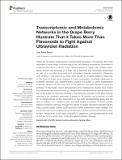Por favor, use este identificador para citar o enlazar a este item:
http://hdl.handle.net/10261/153040COMPARTIR / EXPORTAR:
 SHARE SHARE
 CORE
BASE CORE
BASE
|
|
| Visualizar otros formatos: MARC | Dublin Core | RDF | ORE | MODS | METS | DIDL | DATACITE | |

| Título: | Transcriptomic and Metabolomic Networks in the Grape Berry Illustrate That it Takes More Than Flavonoids to Fight Against Ultraviolet Radiation |
Autor: | Matus, José Tomás CSIC ORCID CVN | Fecha de publicación: | 30-ago-2016 | Editor: | Frontiers Media | Citación: | Frontiers in Plant Science 7: 1337 (2016) | Resumen: | Plants are constantly challenged by environmental fluctuations. In response, they have developed a wide range of morphological and biochemical adaptations committed to ameliorate the effects of abiotic stress. When exposed to higher solar radiation levels, plants activate the synthesis of a large set of enzymes and secondary metabolites as part of a complex sunscreen and antioxidant defense mechanism. Grapevine (Vitis vinifera L.) has become a widely used system for studying adaptive responses to this type of stress since changes in berry composition, positively influenced by increased ultraviolet (UV) radiation levels, improve the quality of wines subsequently produced. Despite the fact that most of the attention has been directed toward the synthesis of flavonoids, recent transcriptomic and metabolomic studies have shown that stilbenoids and isoprenoids (e.g., terpenes and carotenoids) are also an important part of the grape UV-response machinery. This minireview focuses on the latest findings referring to the metabolic responses of grapes to UV radiation and proposes a model for its transcriptional control. Depending on the berry developmental stage and the type of radiation (i.e., irradiance level, exposure length), increased UV levels activate different metabolic pathways through the activity of master regulators belonging to the basic Leucine Zipper Domain (bZIP) and R2R3-MYB transcription factor families. This transcriptional control is influenced by the interaction of other environmental factors such as light, temperature or soil water availability. In grapevine, phenylpropanoids are part of, but are not the whole story, in the fight against radiation damage. | Versión del editor: | http://dx.doi.org/10.3389/fpls.2016.01337 | URI: | http://hdl.handle.net/10261/153040 | DOI: | 10.3389/fpls.2016.01337 | ISSN: | 1664-462X |
| Aparece en las colecciones: | (CRAG) Artículos |
Ficheros en este ítem:
| Fichero | Descripción | Tamaño | Formato | |
|---|---|---|---|---|
| Transcriptomic and Metabolomic Networks in the Grape Berry.pdf | 1,12 MB | Adobe PDF |  Visualizar/Abrir |
CORE Recommender
PubMed Central
Citations
42
checked on 13-abr-2024
SCOPUSTM
Citations
79
checked on 11-abr-2024
WEB OF SCIENCETM
Citations
73
checked on 28-feb-2024
Page view(s)
304
checked on 19-abr-2024
Download(s)
223
checked on 19-abr-2024

